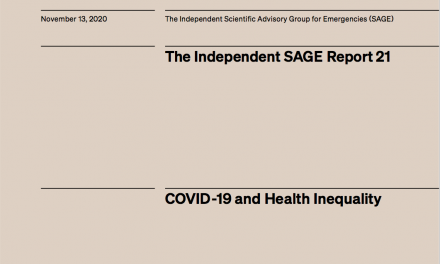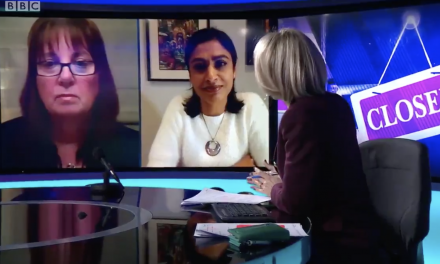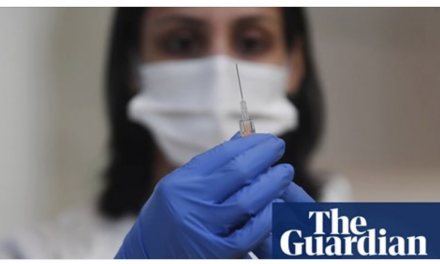The question of why more people from black and ethnic minority (BME) backgrounds appear to be at greater risk of hospitalisation and deaths with COVID-19 – and the need for urgent action in order to address this – has become one of the most urgent issues in this pandemic in the UK.
Click here to read our full report.
It suggests that the reasons why some BME groups appear to be at greater risk of dying with COVID-19 are complex with interplay between socio-economic disadvantage in BME populations, high prevalence of chronic diseases and the impact of long-standing racial inequalities being key explanations.
The Marmot Review in February 2020 highlighted that people from disadvantaged backgrounds or deprived areas, and BME backgrounds, were not only more likely to have underlying health conditions because of their disadvantaged backgrounds, but they were also more likely to have shorter life expectancies as a result of their socio- economic status (including greater representation in poorly paid and insecure employment). Bangladeshi men and Pakistani women were identified as groups with the lowest life expectancy.
Housing conditions, including overcrowding is also likely to have had an impact on vulnerability to COVID-19. Overcrowded households among BME populations are also much more likely to be multigenerational, making social distancing, self-isolation and shielding much more difficult, and increasing opportunities for within-household coronavirus transmission.
We also know that ethnic minorities have been over-represented in key worker jobs during COVID-19: transport and delivery jobs, health care assistants, hospital cleaners, social care workers, taxi drivers, security guards, and in nursing and medical jobs. These occupations have been frontline jobs with increased the risk of exposure, infection and death. There have also been concerns that some of these occupations have been the last to receive supplies of personal protective equipment.
Rates of mortality have also been higher in BME heath care workers. Racial inequalities has been a recurring theme with doctors and nurse surveys experiencing difficulty getting access to personal protection equipment. The long-awaited report from Public Health England on ‘Understanding the impact of COVID-19 on BME groups’ highlighted a pervasive concern among stakeholders: that the experience of racism, discrimination, stigma, fear and trust among black and ethnic minority communities, including key workers within the National Health Service, made BME groups more vulnerable to COVID-19.
It is also important to consider the social and economic consequences of COVID-19 on ethnic minority groups. There is considerable evidence that COVID-19 has amplified pre-existing inequalities. Bangladeshi, Pakistani, Black African and Black Caribbean men are all much more likely to have had jobs in shutdown industries, such as the restaurant sector and taxi driving. These communities are already afflicted with high rates of child poverty with nearly half of Black children and well over half of Pakistani and Bangladeshi children living in poverty.
The COVID-19 pandemic is not just a health crisis; it is also a social and economic one, which in turn will also have a longer term impact on health. It is already clear that this burden of the pandemic is not equal across all population groups; we may all be weathering the same storm, but we are not in the same boat.
In this report, we make a number of recommendations to address the greater risk of adverse health outcomes in BME populations. These include recommendations with immediate impact on the course of the pandemic (to mitigate the differential risk of exposure, infection and transmission, and to inform local outbreak control strategies) and longer-term action to reduce health inequalities.
Short term recommendations
1. Occupational Risk Assessments for all employees and PPE Provision for all workers in public facing roles
Risk assessment for all employees in all workplaces and implement appropriate measures to protect them. Protection arrangements could include working from home, reduced exposure-working practices, temporary furloughing of staff, and guaranteeing that sick leave will not adversely affect employment status. There are a number of risk stratification tools that have already been developed for NHS staff (Khunti et al., 2020) that could be deployed. The Department for Business, Energy and Industrial Strategy (BEIS) and PHE could provide guidance to all employers on how to carry out risk assessments on BME employees as well as all vulnerable groups and mitigation strategies to reduce exposure risk.
Given the Royal College of Nursing and BMA findings of inadequate PPE for BME staff, ensure that all health and social care workers, and indeed key workers in other public-facing roles have access to appropriate PPE.
2. A tailored Find, Test, Trace, Isolate, Support (FTTIS) Programme
As find, test, trace, isolate and support (FTTIS) programmes are developed, including the use of mobile phone applications, they will require adaptation and targeting to ensure that they reach marginalised and BME communities, as well as those with limited proficiency in English (Khunti, 2020), highlighting importance of co-creation of these programme with BME communities. More specific recommendations for each part of FTTIS further detailed below.
Improve Access to Healthcare to improve case-finding and contact tracing
Fear and mistrust among BME and migrant populations may be acting as a barrier to accessing healthcare reducing the likelihood of timely identification of people with COVID-19 symptoms and their contacts. Example steps that could be taken to address this include the improvement of translation services in testing and tracing, implement wide scale cultural diversity training within the health and social care system, engagement with BME communities to build trust, change government policies on healthcare charging regulations for some migrants, as well as the data-sharing agreement between the NHS and the Home Office for immigration enforcement purposes.
Test: Priority Testing
As part of the FTTIS programme, accelerate availability and ramp up priority testing for the most at-risk groups, particularly where people are working in public facing roles. A number of NHS trusts have already implemented this process for BME individuals (Pulse, 2020).
Isolation and Support: Improve Statutory Sickness Pay (SSP)
This support is critical to increase chances of compliance with self-isolation of cases, quarantine of contacts and shielding of the vulnerable. Increase the amount and eligibility for statutory sickness pay. There are concerns about SSP levels in the context of COVID-19. Currently, SSP is too low (£95.85 per week) to live on for working families. Many low pay/zero hour workers and migrants are not eligible for SSP.
3. Increase social security safety net and remove barriers for migrants accessing essential benefits
The government must recognise the impact of poverty and disadvantage on access to social and health care, and disease severity for people within BAME communities. While the government have taken steps to mitigate the economic impact of COVID-19, these measures have not equally benefitted all groups in the labour market (as well as those not active in the labour market).
To protect the most vulnerable sectors of society we recommend the government increases the level of universal credit (which is currently too low and does not take into account changes in circumstances due to COVID-19), increase child benefit (to cover gaps in free school meals and costs of having children at home full time), and align housing allowances with local rent costs, so that the costs of local housing does not push more families into poverty. In addition, benefit caps, under-occupancy benefits and the two-child limit in Universal credit (which means that families with three or more children, born after April 2017, do not receive support for these children) all need to be lifted.
Remove the No Recourse to Public Funds (NRPF) condition that relates to migrants with limited leave, or those without leave to remain. Under the
NRPF, migrant workers with limited or no leave to remain cannot access local authority housing support, public funds including Universal Credit, Child Benefit or Housing Benefit. In addition steps need to be taken to increase trust with authorities, and to open communication between these vulnerable individuals and public sector organisations to aid with access to healthcare and to support uptake of COVID-19 prevention and control measures (Bhopal, 2020).
Key workers are more likely to be from BME populations and be economically vulnerable (Platt, 2020a, ONS, 2020e, McCormack et al., 2020). Remedial action could include relative pay improvements for all currently low paid workers in the health and social care sectors, and, in addition, expansion and improvement in occupational health services, as well as better access to childcare.
4. Provide more housing (e.g.hotels, B&Bs and community shelters) and emergency financial support for necessary isolation during COVID-19
People from disadvantaged areas and black and ethnic minority communities are more likely to live in densely-populated areas, and overcrowded and multigenerational housing. Temporary housing availability (e.g. hotels and community shelters) should be made available to facilitate self-isolation of symptomatic individuals. This will also need to include provision for food and essential amenities. If individuals are to comply with isolation, employers will also need to ensure that those isolating are paid during isolation and do not suffer financial hardship. Looking to the future there is a need for investment in affordable housing and social housing, as well as larger housing specifically aimed at disadvantaged communities.
5. Reverse NHS charges for all new migrants and all levels of workers in the NHS, and remove all data-sharing obligations between NHS and the Home Office
NHS charges for migrants act as a major disincentive for recent migrants and asylum seekers to engage in the health and social care support required to diagnose, treat and prevent COVID-19. Although COVID-19 is specifically excluded from these laws, evidence suggests that many such people remain reluctant to engage in care because of the hostile environment. We support calls for an end to discriminatory NHS charges, as well as use of health data to enforce the Home Office’s “Compliant Environment” policies – all of which act to exclude vulnerable communities from the integrated health and social care system required to eliminate COVID-19.
6. Mandatory data on ethnic background in all health and social care contexts
In light of the clear evidence for excess risk of some BME communities from COVID-19, and the need to mitigate against this adverse outcome, the routine collection and reporting of ethnicity data in health and social care should be mandated. All relevant research studies should collect and present disaggregated ethnicity data, national minimum datasets should include ethnicity data (all existing data sets should be reviewed), and ethnicity should be included in mortality reporting (i.e. death certification) (Pareek et al., 2020). It is critical, however, that health and social care ethnicity data is not shared with non-health agencies, including the Home Office, to ensure that all communities can access health services without fear of immigration enforcement.
7. Undertake and publish all equality impact assessments on previous and new government measures in relation to COVID-19
In addition, for any new policy or policy change during the pandemic, publish an equality impact assessment for all those with protected characteristics, including BME communities. The equality impact assessment should include barriers to adherence to social distancing, taking into consideration the key causes and sources of disparities outlined in this review.
8. NHS Trusts need to undertake an independent review of racial inequalities and discrimination in the NHS
A reoccurring theme throughout the evidence on the impact of COVID19 on ethnic minority communities is the issue of racism and discrimination within the health and social care system, including within the NHS. We therefore recommend that the NHS reiterates its commitment for increasing diverse leadership at all levels in health and care system, reflecting the communities which it serves. It is also critical for NHS Trusts to review processes by which BME staff are able to raise concerns about occupational risk and safety.
Broader long term recommendations
9. Co-creating strategies and policies for primary prevention, secondary prevention, and local outbreak control with BME communities
Ensure that members of BME communities are actively consulted and involved at all stages of the policy process and public information strategies: development, implementation and assessment to foster co-ownership, to build trust, and to ensure that messaging to reducing risk of infection and transmission are appropriate (including availability in a wide range of spoken and written languages (Khunti, 2020) and that approaches to the control of local outbreaks are sensitive to lived experiences and local contexts.
10.Tackle Health Inequality
Improve the prevention and treatment of long-term conditions, with a specific focus on deprived communities and BME individuals. Develop a national, cross-governmental strategy for action on the social determinants of health, with a focus on deprived populations and ethnic minorities (Marmot et al., 2020) to address the differential vulnerability to disease and access to care.
11.Tackle Employment Inequality
Government-level action should be taken to reduce precarious or poorer quality employment which will increase risk of exposure to disease and illness (Marmot et al., 2020). For BME populations, develop a national strategy to break barriers to entry into higher paying occupations; provide clear career development opportunities and pathways; tackle bias in recruitment, promotion and pay decisions; and report on the ethnicity pay/employment gap ( Equality and Human Rights Commission, 2017a, Equality and Human Rights Commission, 2017b). Those from minority ethnic populations are also more likely to be in precarious employment and not be members of Trade Unions, limiting their ability to challenge employers placing them in hazardous situations. (PHE, 2020a, Nazroo and Becares, 2020), although evidence is lacking for this assertion.




